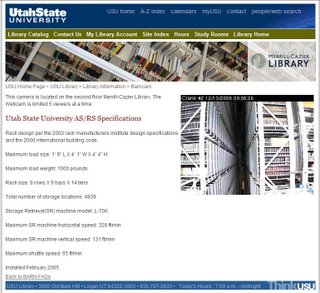"Utah State University’s new Merrill-Cazier Library, opened in the 2005-2006 academic year, is using technology to not only retrieve information from the library catalog, but also retrieve the books themselves. The $42 million project features a state-of-the-art system of robotic stacks, 85 feet high, 60 feet wide, and 120 feet long, which locates requested materials among the 1.5 million volumes and speeds them to patrons—at a rate of 328 feet per minute. The space-saving system allows for many years of collection development. Says Linda Wolcott, vice provost for libraries, “The Merrill-Cazier Library has become the hub of learning on campus, providing the resources, access to technology, and flexible study environments that support the way students learn today.” " (Smart Library, Campus Technology, 12/2006)

Unfortunately, the article made no further mention regarding exactly what books were housed within the USU Merrill-Cazier Library retrieval system, the BARN. Sharing my finding with two student workers, I wondered if it was the entire library or specific collections within the library utilizing the system. In all honesty, we were a bit taken aback by the idea of a juvenile collection being part of this storage since it is routinely a frequently browsed area in our library. I was intrigued enough to want to learn more. They were concerned I watched the availabe web cam to see how it worked. Check out the BARN (ASRS) page on the USU Merrill-Cazier library web site to learn about what the BARN is, why they chose a BARN, and what is housed in their BARN. For anyone wondering what BARN stands for, it means Borrower's Automated Retrieval Network; a much simpler, catchier acronym than ASRS or Automated Storage and Retrieval System.
With what may be a growing trend, how many institutions can actually afford this technology? I would imagine it is not something smaller and/or mid-sized academic libraries will quickly adopt. Not just because of the cost issue, but also because collections may not warrant off-site storage of any type. Either way, it sheds an interesting light on the shelf shifting I have been doing in the library juvenile collection for the last 4 - 6 weeks. Creating additional room where no room exists is an ongoing challenge, even an opportunity. In retrospect, a nice little robotic arm would have been welcomed.
Here are a few academic libraries in Canada and the US utilizing ASRS:
- University of British Columbia
- Eastern Michigan University
- Sonoma State University
- Oxford University Gazette
Tags: ASRS, Automated storage and retrieval systems, Academic libraries and ASRS, Utah State University, USU Merrill-Cazier Library, Campus Technology
No comments:
Post a Comment